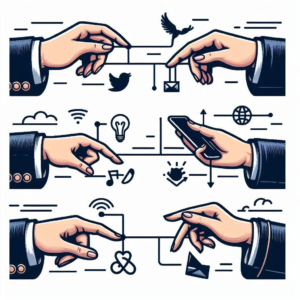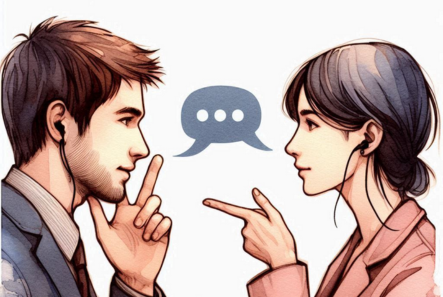Intro
Effective communication goes beyond just the words we speak. Non-verbal communication plays a crucial role in conveying our messages and connecting with our audience. Understanding how to utilize body language, posture, gestures, and eye contact can significantly enhance your communication skills and help you command attention in any situation.
The Foundations of Effective Non-Verbal Communication
Unlocking the secret language of non-verbal communication is akin to discovering a superpower you never knew you had. At its core, this unspoken language includes the subtle yet powerful expressions we wear on our faces, the stance we take, the gestures we employ, and even the variations in our voice that accompany our words. Imagine walking into a room and, without uttering a single syllable, conveying confidence, openness, and readiness to engage. That’s the magic of mastering non-verbal cues.
 The journey to enhancing your non-verbal communication skills begins with an awareness of the components that make up this silent language. Facial expressions, for instance, can speak volumes about your emotions and attitudes, often more eloquently than words ever could. A genuine smile can bridge gaps, while a furrowed brow might signal concern or confusion.
The journey to enhancing your non-verbal communication skills begins with an awareness of the components that make up this silent language. Facial expressions, for instance, can speak volumes about your emotions and attitudes, often more eloquently than words ever could. A genuine smile can bridge gaps, while a furrowed brow might signal concern or confusion.
Your posture and the way you move also send strong messages to those around you. A slouched stance may inadvertently suggest disinterest or lack of confidence, while standing tall and moving with purpose radiates self-assurance and respect for your audience.
Even the way you position your hands and arms plays into the narrative you’re sharing. Open gestures can invite connection and signify honesty, while crossed arms might be perceived as defensive or closed off.
Voice, too, is a critical element of non-verbal communication. The tone, pitch, and pace of your speech can complement your message, adding depth and emotion that words alone may fail to convey.
Becoming adept at non-verbal communication isn’t just about controlling these elements; it’s about aligning them with your spoken words to create a harmonious and compelling message. It’s about leveraging the unspoken to connect on a deeper level, making every interaction more meaningful and impactful. As you embark on this journey of non-verbal exploration, remember: the subtle cues you send can significantly shape the perceptions of those around you, paving the way for richer, more authentic connections.
The Power Stance: Owning Your Space
Imagine entering a room and, with just the way you stand, commanding immediate respect and attention from everyone present. That’s the influence of adopting a power stance. This isn’t about dominating the space with arrogance but about embracing a posture that exudes confidence and authority. Your stance can speak as loudly as your voice, signaling to your audience that you’re a force to be reckoned with, even before you’ve started to speak.
 To master the power stance, start by standing with your feet shoulder-width apart, ensuring your weight is evenly distributed. This position provides a solid foundation, making you appear grounded and steadfast. It’s essential to keep your shoulders back and your spine straight but not stiff. The goal is to look poised, not rigid. Such a stance not only boosts how others perceive you but also influences how you feel about yourself. Research has shown that adopting a powerful pose can increase feelings of confidence and even affect hormone levels, reducing stress and making you feel more in control.
To master the power stance, start by standing with your feet shoulder-width apart, ensuring your weight is evenly distributed. This position provides a solid foundation, making you appear grounded and steadfast. It’s essential to keep your shoulders back and your spine straight but not stiff. The goal is to look poised, not rigid. Such a stance not only boosts how others perceive you but also influences how you feel about yourself. Research has shown that adopting a powerful pose can increase feelings of confidence and even affect hormone levels, reducing stress and making you feel more in control.
When you own your space, you’re not just physically occupying a spot; you’re claiming the attention and respect of those around you. It tells your audience that you believe in what you’re about to say, making them more inclined to listen and believe in it, too. Embracing and mastering the power stance is a subtle yet powerful way to enhance your non-verbal communication, ensuring that your presence is felt and your message, even more compelling.
Gesture with Purpose: Enhancing Your Message
In the dance of dialogue, your hands can be eloquent speakers, capable of underscoring your key points and drawing your audience deeper into the conversation. But just as a misstep in a dance can disrupt the flow, unnecessary or aimless gestures can distract from your message rather than enhance it. The secret lies in harnessing your gestures with intention, allowing them to become an integral part of your communication repertoire.
 Begin by aligning your movements with the natural rhythm of your speech. Just as a conductor uses their baton to emphasize the music’s highs and lows, let your gestures highlight the critical moments of your narrative. A well-timed hand movement can illuminate a point, while open palms can signal honesty and inclusivity, fostering a stronger connection with your audience.
Begin by aligning your movements with the natural rhythm of your speech. Just as a conductor uses their baton to emphasize the music’s highs and lows, let your gestures highlight the critical moments of your narrative. A well-timed hand movement can illuminate a point, while open palms can signal honesty and inclusivity, fostering a stronger connection with your audience.
However, be wary of over-gesticulation. An excessive display can muddle your message, leaving your audience to focus more on your hands than on what you’re saying. Strive for balance, using gestures to create emphasis rather than distraction.
Remember, the congruence between your words and actions strengthens your message’s impact. When your verbal and non-verbal languages sing in harmony, you not only command the room but also leave an indelible mark on the hearts and minds of your audience. Embrace the power of purposeful gestures as part of your communication toolkit, and watch as your messages resonate more profoundly than ever before.
The Art of Making Eye Contact
Eye contact is the invisible thread that connects speaker and listener, a fundamental yet powerful element of non-verbal communication. Locking eyes, even briefly, signals to your audience that you are fully present and deeply invested in the exchange. It’s a gesture that says, “I see you, and I value this connection.” This simple act can transform a mere presentation into a shared experience, creating an atmosphere of engagement and trust.
But mastering eye contact is a delicate balance. Staring too intently can feel intimidating, while glancing away too often might come across as disinterest or, worse, insincerity. The trick is to find that sweet spot—maintaining eye contact just long enough to forge a connection, then briefly looking away to give your audience a comfortable space. Think of it as a visual dance, one that invites your listeners into your narrative without overwhelming them.
Incorporating eye contact into your communication arsenal doesn’t just bolster your message; it also allows you to gauge your audience’s reactions. Notice their cues—are they nodding in agreement, or are brows furrowed in confusion? This feedback loop is invaluable, enabling you to tailor your delivery in real-time for maximum impact.
To hone this skill, practice with friends or in front of a mirror. Observe the natural ebb and flow of eye contact in everyday conversations and strive to replicate that rhythm in more formal settings. With time and practice, making eye contact will become a natural extension of your communication style, one that draws your audience in and holds them captive to your every word.
Reading the Room: Adjusting Non-Verbal Cues in Real-Time
Understanding the subtle art of reading the room and adapting your non-verbal communication in real-time is akin to becoming a communication chameleon. This skill allows you to seamlessly blend your message with the mood and expectations of your audience, creating a dynamic interaction that resonates on a deeper level. It’s about being acutely aware of the unspoken dialogue in the room—observing the collective posture, facial expressions, and even the energy of your audience to gauge their engagement and receptivity.
Imagine you’re sharing an important message, and you notice a sea of furrowed brows or crossed arms. This immediate feedback is invaluable; it’s a cue to perhaps shift your stance, open up your gestures, or inject warmth into your tone to re-engage your listeners. Adjusting your non-verbal cues isn’t about altering your message but about modulating its delivery to ensure it lands as intended, fostering a stronger connection.
Mastering this skill requires a blend of empathy and adaptability. It means being present and connected, not just to your message but to the people you’re sharing it with. Pay close attention to the non-verbal feedback you’re receiving, and be prepared to pivot your approach on the fly. This could mean slowing down your pace to allow your words to sink in, using more expressive gestures to underline a critical point, or even taking a step closer to your audience to close the emotional distance.
Navigating the nuanced dance of real-time adjustment in non-verbal cues is a powerful tool in your communication arsenal. It transforms a monologue into a dialogue, where your audience doesn’t just hear your message—they feel it.
Practice Makes Perfect: Incorporating Non-Verbal Cues into Your Preparation
To truly excel in the realm of non-verbal communication, integrating these cues into your preparatory routine is indispensable. It’s about making the invisible, visible; transforming subconscious signals into deliberate gestures that amplify your spoken words. Start by creating a space where you can observe yourself—a mirror serves well for immediate feedback, while video recordings offer the advantage of playback analysis. As you rehearse, pay particular attention to the nuances of your body language. Are your gestures synchronized with the peaks and troughs of your narrative? Does your posture project the confidence you wish to convey?
 This practice isn’t just about critique; it’s a process of self-discovery and refinement. Notice the moments when your non-verbal cues naturally align with your message—these are your strengths to build upon. Equally, identify habits that may detract from your presence, such as fidgeting or inconsistent eye contact, and consciously work to mitigate these. Remember, the goal is not to cultivate a performance but to foster an authentic embodiment of your message that resonates with your audience.
This practice isn’t just about critique; it’s a process of self-discovery and refinement. Notice the moments when your non-verbal cues naturally align with your message—these are your strengths to build upon. Equally, identify habits that may detract from your presence, such as fidgeting or inconsistent eye contact, and consciously work to mitigate these. Remember, the goal is not to cultivate a performance but to foster an authentic embodiment of your message that resonates with your audience.
Involving a trusted friend or coach in this process can offer invaluable external perspectives, providing feedback that might be missed in self-assessment. Through dedicated practice, the integration of non-verbal communication into your repertoire becomes second nature, empowering you to engage and influence with both grace and authority.
Common Pitfalls in Non-Verbal Communication and How to Avoid Them
Navigating the landscape of non-verbal communication is fraught with potential missteps that can easily derail the effectiveness of your message. One such pitfall is the tendency to fidget, which can signal nervousness or distract your audience from the substance of your message. To counter this, focus on grounding your movements and practice stillness when not using purposeful gestures.
 Another common error involves avoiding eye contact, which can create a barrier between you and your audience, making your message seem insincere or disengaged. Aim for a balance in eye contact, offering enough to connect personally with individuals in your audience without becoming overly intense.
Another common error involves avoiding eye contact, which can create a barrier between you and your audience, making your message seem insincere or disengaged. Aim for a balance in eye contact, offering enough to connect personally with individuals in your audience without becoming overly intense.
Closed-off body language, such as crossed arms or turning away from your audience, can also signal disinterest or defensiveness. Cultivating an open posture not only invites your audience in but also fosters an environment of trust and receptivity.
Awareness of these pitfalls is the first step toward avoiding them. With mindful practice and a commitment to aligning your non-verbal cues with your intended message, you can navigate these common errors and ensure your non-verbal communication enhances rather than detracts from your message.
Harnessing the Power of Silence
In the bustling symphony of communication, silence often goes unnoticed, yet it holds immense power to transform the cadence of our interactions. Think of silence as the pause between musical notes, essential for creating rhythm and meaning. When wielded with purpose, these moments of quiet can underscore your message, inviting reflection and heightening anticipation among your audience.
 Embracing silence can feel counterintuitive in a culture that prizes constant communication. However, strategic pauses during a speech or conversation serve to emphasize key points, allowing your words to resonate more deeply. Silence gives your audience time to digest complex ideas, sparking curiosity and engagement. It’s in these quiet moments that your message can truly settle in, making a lasting impact.
Embracing silence can feel counterintuitive in a culture that prizes constant communication. However, strategic pauses during a speech or conversation serve to emphasize key points, allowing your words to resonate more deeply. Silence gives your audience time to digest complex ideas, sparking curiosity and engagement. It’s in these quiet moments that your message can truly settle in, making a lasting impact.
Moreover, silence is not just a tool for emphasis but also a signal of confidence and composure. By allowing silence to inhabit spaces in your dialogue, you demonstrate comfort with your message and respect for the listening experience. It’s a subtle nod to the value of thoughtful communication over relentless chatter.
To master the art of silence, practice incorporating pauses into your speech patterns. Observe the effect on your audience—their increased attentiveness, the heightened impact of your words, and the deeper connection forged. In the nuanced dance of communication, silence is a step that, when executed with intention, can elevate your message and captivate your audience like never before.
Additional Resources:

